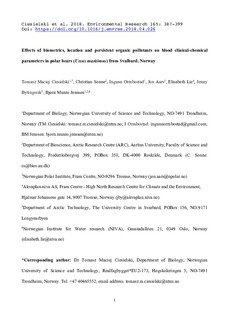Effects of biometrics, location and persistent organic pollutants on blood clinical-chemical parameters in polar bears (Ursus maritimus) from Svalbard, Norway
| dc.contributor.author | Ciesielski, Tomasz Maciej | |
| dc.contributor.author | Sonne, Christian | |
| dc.contributor.author | Ormbostad, Ingunn | |
| dc.contributor.author | Aars, Jon | |
| dc.contributor.author | Lie, Elisabeth | |
| dc.contributor.author | Bytingsvik, Jenny | |
| dc.contributor.author | Jenssen, Bjørn Munro | |
| dc.date.accessioned | 2019-03-21T07:40:56Z | |
| dc.date.available | 2019-03-21T07:40:56Z | |
| dc.date.created | 2018-07-06T11:58:22Z | |
| dc.date.issued | 2018 | |
| dc.identifier.citation | Environmental Research. 2018, 165 387-399. | nb_NO |
| dc.identifier.issn | 0013-9351 | |
| dc.identifier.uri | http://hdl.handle.net/11250/2590963 | |
| dc.description.abstract | In the present study, blood clinical-chemical parameters (BCCPs) were analysed in 20 female and 18 male Svalbard polar bears (Ursus maritimus) captured in spring 2007. The aim was to study how age, body condition (BC), biometrics, plasma lipid content and geographical location may confound the relationship between persistent organic pollutants (POPs) including PCBs, HCB, chlordanes, DDTs, HCHs, mirex and OH-PCBs and the concentrations of 12 specific BCCPs (hematocrit [HCT], hemoglobin [HB], aspartate aminotransferase [ASAT], alanine aminotransferase [ALAT], γ-glutamyltransferase [GGT], creatine kinase [CK], triglycerides [TG], cholesterol [CHOL], high-density lipoprotein [HDL], creatinine (CREA], urea, potassium (K]), and to investigate if any of these BCCPs may be applied as potential biomarkers for POP exposure in polar bears. Initial PCA and O-PLS modelling showed that age, lipids, BC and geographical location (longitude and latitude) were important parameters explaining BCCPs in females. Following subsequent partial correlation analyses correcting for age and lipids, multiple POPs in females were still significantly correlated with HCT and HDL (all p < 0.05). In males, age, BM, BC and longitude were important parameters explaining BCCPs. Following partial correlation analyses correcting for age, biometrics, lipids and longitude in males, multiple POPs were significantly correlated with HCT, ASAT, GGT and CHOL (all p < 0.05). In conclusion, several confounding parameters has to be taken into account when studying the relations between BCCPs and POPs in polar bears. When correcting for these, in particular HCT may be used as a simple cost-efficient biomarker of POP exposure in polar bears. Furthermore, decreasing HDL concentrations and increasing CHOL concentration with increasing POP concentrations may indicate responses related to increased risk of cardiovascular disease. We therefore suggest to further study POP exposure and lipidome response to increase knowledge of the risk of cardiometabolic syndrome in polar bears. | nb_NO |
| dc.description.abstract | Effects of biometrics, location and persistent organic pollutants on blood clinical-chemical parameters in polar bears (Ursus maritimus) from Svalbard, Norway | nb_NO |
| dc.language.iso | eng | nb_NO |
| dc.publisher | Elsevier | nb_NO |
| dc.rights | Attribution-NonCommercial-NoDerivatives 4.0 Internasjonal | * |
| dc.rights.uri | http://creativecommons.org/licenses/by-nc-nd/4.0/deed.no | * |
| dc.title | Effects of biometrics, location and persistent organic pollutants on blood clinical-chemical parameters in polar bears (Ursus maritimus) from Svalbard, Norway | nb_NO |
| dc.type | Journal article | nb_NO |
| dc.type | Peer reviewed | nb_NO |
| dc.description.version | acceptedVersion | nb_NO |
| dc.source.pagenumber | 387-399 | nb_NO |
| dc.source.volume | 165 | nb_NO |
| dc.source.journal | Environmental Research | nb_NO |
| dc.identifier.doi | 10.1016/j.envres.2018.04.026 | |
| dc.identifier.cristin | 1596097 | |
| dc.relation.project | Norges forskningsråd: 175989 | nb_NO |
| dc.description.localcode | © 2018. This is the authors’ accepted and refereed manuscript to the article. Locked until 31 May 2020 due to copyright restrictions. This manuscript version is made available under the CC-BY-NC-ND 4.0 license http://creativecommons.org/licenses/by-nc-nd/4.0/ | nb_NO |
| cristin.unitcode | 194,66,10,0 | |
| cristin.unitname | Institutt for biologi | |
| cristin.ispublished | true | |
| cristin.fulltext | postprint | |
| cristin.qualitycode | 2 |
Tilhørende fil(er)
Denne innførselen finnes i følgende samling(er)
-
Institutt for biologi [2616]
-
Publikasjoner fra CRIStin - NTNU [38672]

